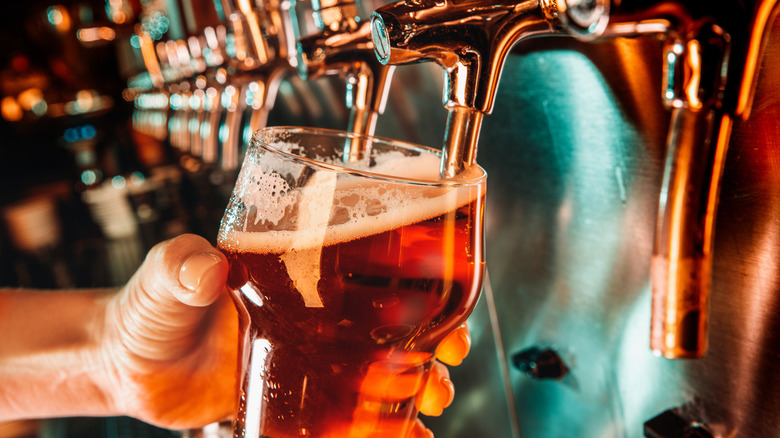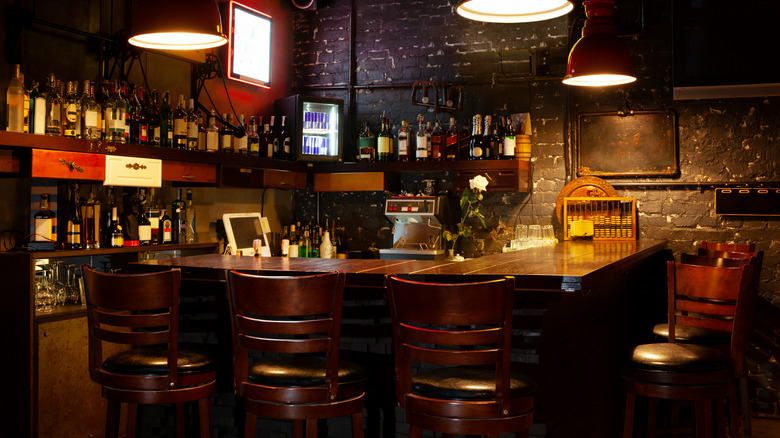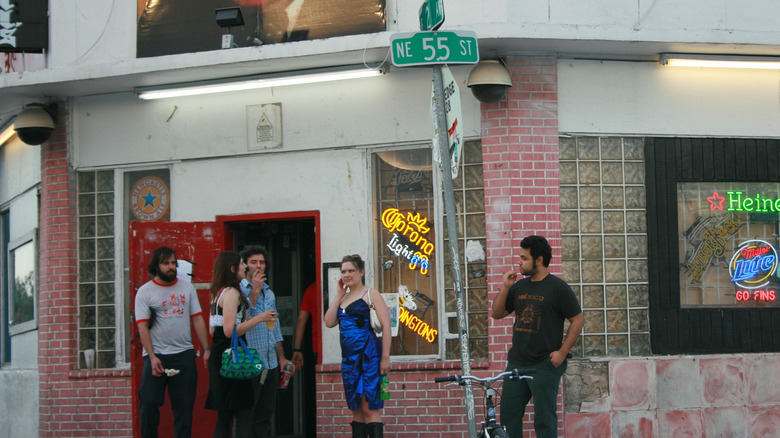Tavern Vs Bar: What's The Difference?
From pubs to dives to taverns to watering holes, the "bar" is a sacred institution of many names. Whatever you call yours, drinking establishments are deeply personal to their fans. The Stonewall riots came out of bars, and the hit television show "Cheers" is all about people hanging out at their favorite local spot. Considering the barstool is the great unifier (doctors, lawyers, and shoe-shiners all sit at the same seat), differentiating a "tavern" from a "bar" might pose a challenging task. It's like how all squares are rectangles, but not all rectangles are squares — a tavern is a bar, but a bar isn't necessarily a tavern.
Perhaps the most obvious difference between bars and taverns is their offerings. Taverns almost always serve food, while bars can serve food but also might only serve drinks. Whereas bars can serve liquor, beer, bitters, or any other spirits (some bars just serve mocktails), taverns tend to focus on tapped beers. Still, as any seasoned barfly knows and would be glad to tell you, the differences between a tavern and a bar are far more numerous and nuanced than the menu alone. A $20 cocktail spot with a dress code is technically a bar, but so is the place with graffitied bathrooms and bras hanging from the ceiling — and so is Buffalo Wild Wings. To glean a technical definition of "tavern," a glimpse backward in history can be useful.
Taverns are more old-fashioned and community-centric (plus food)
The taberna meritoria were the better-class taverns of ancient Rome that served full sit-down meals and were reserved for those who could afford to go. Those on the margins of society but could still swing the occasional food and drink out frequented the popular hangouts known as taberna. In the Middle Ages in England, taverns evolved into alehouses, which served one daily meal at a fixed time. These establishments were part bar, part restaurant, and part inn, providing temporary lodging for travelers and other nomadic patrons like criminals and political refugees. American Revolutionaries planned their battles in taverns, and until the mid-1800s, taverns were open to women and children. Popular favor shifted toward bars after Prohibition (1920-1933), as bars more closely resembled the speakeasies folks had grown fond of, and women were at first seldom allowed at these establishments.
So, what does this all mean? Minus the lodging part, the tavern's history and reputation have colored its modern understanding. Whereas bars are focused on alcohol, taverns encompass the realms of alcohol, food, and environment. You can grab a solo beer at a bar, but at a tavern, a sense of community permeates the scene as a social meeting place, not dissimilar to a coffee shop or salon. Taverns also tend toward old-fashioned atmospheres with a cozy, warm ambiance. The terms "pub" and "tavern" are largely interchangeable, with the exception of pubs having an inherently English or Irish origin.
A bar is a bar no matter where you are
Upon entering a bar, the first thing you're likely to notice (other than the smell) is the ambiance. The ambiance of a tavern says tradition, and low lighting and stone or wood paneling are probable. A bar, on the other hand, doesn't have to promise an ounce of tradition. If it has rainbow string lights, it's a bar. If you're sipping a Cosmopolitan, you are 100% not at a tavern. They run the gamut from the lowly dive to airport to classy rooftop but expect to find hard drinks in all the popular brands.
Taverns also tote regional differences that bars lack. Fare steeped in cultural heritage like scotch eggs, pierogies, or soft pretzels are linked to English, Polish, and German traditions (tavern). A European football game might be playing on a flatscreen television. At a bar, throw all that beautiful cultural reverence out the spray-painted window. "Bar culture" is your heritage now. (Think guitar solos, onion rings, Keno, old concert posters, and pool tables.)
Another key differentiator is the entertainment. If you're sipping a pint of draft beer while listening to a four-piece string band and no one in the quartet is younger than 50, you could be sitting in a tavern. But, if you slam a well tequila shot just in time to see three shaggy-haired twenty-somethings collectively called "Knife Fight" plugging in amps, you're in a bar.


